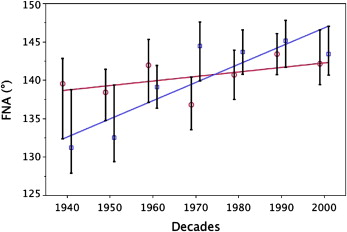Introduction
The goals of this study were to investigate differences between the most popular female and male faces, past and present, and to determine whether they had changed over time and, if so, to what extent.
Methods
Internet film databases were searched for photographs of men and women who were considered attractive between 1940 and 2008. Images meeting defined inclusion criteria were compared. Measurements were taken on a minimum of 20 images per sex per decade. Intersex facial differences were grouped by decades, and we examined whether these differences remained stable or whether and how they changed over time.
Results
The women had fuller and more protrusive lip profiles than did the men, particularly during the first decade of the 21st century. Significant sex-specific developments were noted over time with respect to chin lengths, frontonasal angles, and total face angles. The men had decreases in chin size and length, but a small opposite trend was observed in the women’s faces. During the observation period, female and male faces considered highly attractive became slightly more similar in terms of chin position and size.
Conclusions
Notions of facial attractiveness might be influenced by developments in society.
Editor’s comment
Practitioners are more likely now than ever before to discuss soft-tissue facial treatment objectives with patients before treatment, so one wonders whether the public’s treatment goals have changed over the years. The purpose of this study was to identify intersex differences between faces considered beautiful and attractive 70 years ago. Another objective was to determine whether these views have changed over time and, if so, to what extent. Internet film databases were searched for photographs of men and women considered attractive. The observation period was 1940 to 2008. A total of 400 images were selected (200 of men, 200 of women), all based on specific criteria. You are encouraged to read the entire article online for a better understanding of the facial landmarks identified for comparison.
Based on their findings, the authors believe that perceived facial attractiveness varies with fashion. Today, faces with fuller and more protrusive lip profiles are preferred. Both sexes exemplify this trend. Significantly different developments in female- and male-judged attractiveness can be observed for the parameters of chin length, frontonasal angle, and total facial angle. Men had decreases with minor oscillating variations in both total face angle and chin length, whereas upturns and downturns and a small opposite trend were observed in women. This meant that the profile of male faces considered attractive became more convex, and the length of the chin became shorter. In general, men’s chin appearance has shown a trend toward more female traits. The authors believe that “Developments in society potentially have played a role in influencing the perceived attractiveness of facial profiles.”





